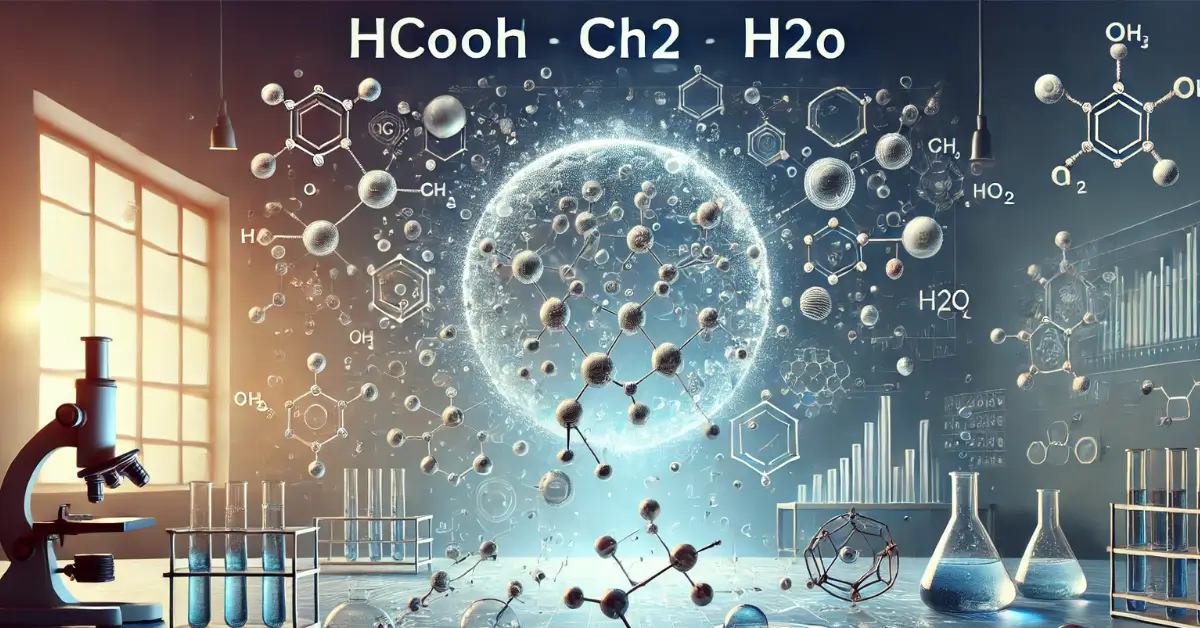In the intricate world of chemistry, a combination of compounds can reveal extraordinary applications. HCOOH, also known as formic acid, CH2, the versatile methylene group, and H2O, the universal solvent, together offer intriguing insights into chemical reactions and practical uses. This article delves deep into their properties, applications, and significance, shedding light on their role in scientific and industrial domains.
With growing interest in organic chemistry, the exploration of HCOOCH CH2 H2O like compounds brings a sense of excitement and understanding. From industrial solvents to biological roles, they showcase chemistry’s ability to intertwine nature and innovation.
HCOOH CH2 H2O: A Comprehensive Overview
The combination of formic acid (HCOOH), CH2 (methylene group), and H2O (water) represents a cornerstone in understanding organic and inorganic reactions. Each component plays a distinct role in shaping the dynamics of chemistry.
Formic acid, the simplest carboxylic acid, is renowned for its natural occurrence, notably in ant venom. CH2, a pivotal organic fragment, forms the backbone of countless molecular structures. Water (H2O) acts as the medium where these interactions flourish, enabling transformations essential to both life and industry.
Chemical Properties of Formic Acid (HCOOH)
Formic acid is a colorless liquid with a pungent odor, serving as a versatile compound in chemistry. It is highly polar, allowing it to dissolve in water and participate in numerous reactions. Its acidic nature, derived from the carboxylic acid group, makes it a potent reagent in organic synthesis.
Additionally, formic acid undergoes decomposition into hydrogen and carbon dioxide, making it an environmentally friendly choice in various applications. This decomposition highlights its dual role as a chemical agent and a potential green energy source.
Role of Methylene Group (CH2) in Organic Chemistry
The methylene group (CH2) is a critical building block in organic compounds. Its reactivity stems from its ability to form single or double bonds, enabling the creation of complex molecules.
In synthesis, CH2 facilitates reactions like chain elongation and cross-linking, forming polymers and other essential materials. Its applications extend to pharmaceuticals, where its presence determines the efficacy of several compounds.
Also Read: New Animal Homophone: Explore Fun Examples and Meanings in English
Importance of Water (H2O) in Chemical Reactions
Water (H2O) is indispensable in chemistry, acting as a solvent, catalyst, and reactant. Its polar nature allows it to dissolve ionic and polar compounds, creating a medium for reactions.
In the context of HCOOH and CH2, water aids in acid-base reactions and supports the stability of intermediate compounds. Its unique properties, such as hydrogen bonding, ensure it remains central to scientific exploration and practical applications.
Industrial Applications of Formic Acid and Water
Formic acid and water find extensive use in industrial processes. Formic acid is a popular choice in leather tanning, textile dyeing, and as an industrial cleaner. Its antibacterial properties make it valuable in agriculture, especially as a preservative for silage.
Water, with its unparalleled solvent capabilities, complements formic acid in creating efficient solutions. Together, they contribute to innovations in green chemistry, reducing the reliance on harmful chemicals.
Biological Significance of Formic Acid in Nature
In nature, formic acid plays a vital role in biological ecosystems. Found in ant venom, it serves as a defense mechanism and a communication tool for insects. Its antibacterial properties also make it a natural preservative.
Moreover, its interaction with H2O demonstrates its adaptability, supporting biological processes across various organisms. This dual functionality bridges the gap between natural chemistry and human applications.
HCOOH and CH2: Their Role in Organic Compound Synthesis
HCOOH and CH2 are instrumental in synthesizing complex organic compounds. Formic acid acts as a precursor in the production of formates, which are critical intermediates in pharmaceuticals and pesticides.
The methylene group enhances these processes, enabling the creation of diverse molecular architectures. Their combined efficiency showcases the versatility of organic synthesis, fostering advancements in various industries.
Hydrogen Bonding and Solvent Properties of Water
The phenomenon of hydrogen bonding in H2O is a cornerstone of its chemical behavior. These bonds influence water’s high boiling point, surface tension, and solvent properties.
When paired with HCOOH and CH2, water’s ability to stabilize reactions becomes evident. It ensures the smooth progression of acid-base reactions, highlighting its role as a universal facilitator in chemistry.
Environmental Impacts of HCOOH and H2O in Chemistry
The use of formic acid and water aligns with sustainable practices in chemistry. Formic acid’s biodegradability minimizes environmental harm, making it an ideal choice for eco-friendly processes.
Similarly, water’s abundance and recyclability underscore its importance in reducing the ecological footprint of industrial activities. Together, they represent a shift towards responsible and sustainable chemical applications.
Reactions Involving HCOOH CH2 H2O: Key Insights
The interplay of HCOOH, CH2, and H2O creates a diverse array of reactions. From esterification to polymerization, these compounds showcase their adaptability in various scenarios.
Their ability to participate in both organic and inorganic reactions underpins advancements in synthetic chemistry, highlighting their indispensable role in modern science.
Final Thoughts
The combination of formic acid, methylene group, and water represents the synergy of nature and chemistry. Their unique properties and wide-ranging applications inspire continued exploration, fostering innovation and sustainability.
With their contributions to organic synthesis, industrial processes, and environmental sustainability, these compounds remain at the forefront of chemical research and application.
Also Read: MarineNet: The Ultimate Online Training Hub for USMC Professionals
FAQs
Q1. What is the primary use of formic acid (HCOOH)?
Formic acid is widely used as an antibacterial agent, industrial cleaner, and precursor in organic synthesis.
Q2. How does the methylene group (CH2) contribute to organic chemistry?
The methylene group forms bonds that enable the creation of complex molecular structures, supporting various industrial and pharmaceutical applications.
Q3. Why is water (H2O) crucial in chemical reactions?
Water acts as a solvent, catalyst, and medium for reactions, facilitating processes essential for life and industry.
Q4. What are the environmental benefits of HCOOH?
Formic acid is biodegradable and eco-friendly, making it suitable for sustainable industrial practices.
Q5. How do HCOOH, CH2, and H2O interact in chemical processes?
Their interactions lead to diverse reactions, such as esterification and polymerization, showcasing their versatility in chemistry.










